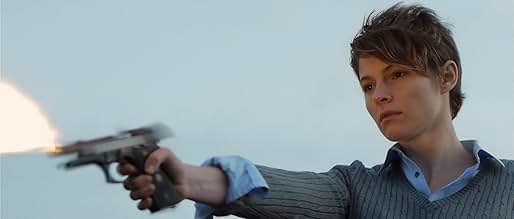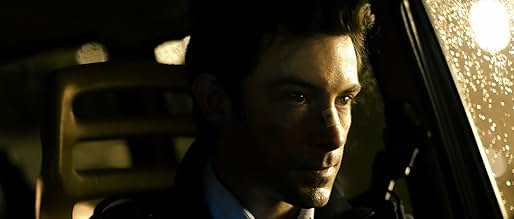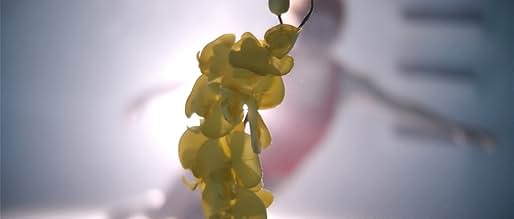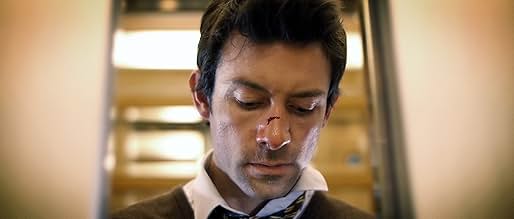VALUTAZIONE IMDb
6,5/10
35.716
LA TUA VALUTAZIONE
Un uomo e una donna sono attratti insieme, invischiati nel ciclo vitale di un organismo senza età. L'identità diventa un'illusione mentre lottano per assemblare i frammenti sciolti di vite d... Leggi tuttoUn uomo e una donna sono attratti insieme, invischiati nel ciclo vitale di un organismo senza età. L'identità diventa un'illusione mentre lottano per assemblare i frammenti sciolti di vite distrutte.Un uomo e una donna sono attratti insieme, invischiati nel ciclo vitale di un organismo senza età. L'identità diventa un'illusione mentre lottano per assemblare i frammenti sciolti di vite distrutte.
- Regia
- Sceneggiatura
- Star
- Premi
- 5 vittorie e 35 candidature totali
Andreon Michael
- Peter
- (as Andreon Watson)
John Walpole
- Bank Investigator
- (as Trey Walpole)
Recensioni in evidenza
Here's a film which ponders suffering and celebrates beauty and meaning, so at least on this count I am firmly behind it.
The point is how to have the lesson, for instance that love redeems, which we know in words but often eludes us in life as experience that needs no explaining beyond itself, as actual insight, as something which wrapping it around us we will know its warmth by simple feel.
Well, most serious films try something of the sort.
Usually how it works, is that there is an interplay of 'hard' and 'soft' elements. Hard would be all the stuff that particularize and discriminate, the more of these we have the harder it is to have unmediated insight because what happens in the story registers in a topical way, for instance a story of female Irish workers in the sewing industry of 1915. Soft is the flow of urges and self as one space for reflection, Malick's latest seems to be the pinnacle at around this time. Wong Kar Wai does it.
Usually, we start with some 'hard' particulars and open up in a 'soft' way, shedding self. But now and then, we get a major blunder like Cloud Atlas where the point is the soft insight of interconnected life but that is fenced on all sides by hard impositions, conspiracies, gunfights etc.
This is a weird, complicated narrative, unnecessarily so for my taste but once you see past the complexity, it is a simple thing. The idea is that there is something in nature which worms its way into the soul and is the cause of all suffering. Seemingly this is producing the anomalies that manifest in the narrative, if suffering sounds overly religious call it an existential dissatisfaction or malaise. We get to see the effect of this in a relationship between a man and woman, how what is eating them keeps tossing them apart and together again.
The 'soft' portion of the film is this tumultuous relationship, the point is it could be yours. We have digress, dissonance, reluctance, knowing and knowing the other so well you can't tell his memories from your own. Some marvellous birdwatching, love as agreeing on the same birds.
Kar Wai is king of this 'pure' emotional space, because he traces particulars faintly into the night, the yearning and alienation as something elusive in the air. Malick which this film reminds of, renders them as huge, abstract forces that buffet us, war or loss.
Here, the entire framework is schematic and 'hard' in the extreme, an actual worm, hypnosis, a sinister surgery of some kind, more clearly the man who keeps the pigs fenced and wanders around trying to 'capture' on tape the manifold sounds, which stands for a broader human endeavor.
I find that this approach cheapens and reduces. Suddenly it is about technology and greed, a clumsy set of metaphors.
So overall, this comes heavily on the side of a silly eccentricity. Next to Malick who is an influence in the solemnity of atmosphere, I was reminded at times of Synecdoche, Wax: Or the Invention of Television among the Bees, Southland Tales, even Begotten, all of them ambitious ventures constrained by a symbolic notation on the ideas.
The ending is so silly it has to be seen, the choice of metaphors is the most ludicrous since Cremaster which all but destroys the film.
The point is how to have the lesson, for instance that love redeems, which we know in words but often eludes us in life as experience that needs no explaining beyond itself, as actual insight, as something which wrapping it around us we will know its warmth by simple feel.
Well, most serious films try something of the sort.
Usually how it works, is that there is an interplay of 'hard' and 'soft' elements. Hard would be all the stuff that particularize and discriminate, the more of these we have the harder it is to have unmediated insight because what happens in the story registers in a topical way, for instance a story of female Irish workers in the sewing industry of 1915. Soft is the flow of urges and self as one space for reflection, Malick's latest seems to be the pinnacle at around this time. Wong Kar Wai does it.
Usually, we start with some 'hard' particulars and open up in a 'soft' way, shedding self. But now and then, we get a major blunder like Cloud Atlas where the point is the soft insight of interconnected life but that is fenced on all sides by hard impositions, conspiracies, gunfights etc.
This is a weird, complicated narrative, unnecessarily so for my taste but once you see past the complexity, it is a simple thing. The idea is that there is something in nature which worms its way into the soul and is the cause of all suffering. Seemingly this is producing the anomalies that manifest in the narrative, if suffering sounds overly religious call it an existential dissatisfaction or malaise. We get to see the effect of this in a relationship between a man and woman, how what is eating them keeps tossing them apart and together again.
The 'soft' portion of the film is this tumultuous relationship, the point is it could be yours. We have digress, dissonance, reluctance, knowing and knowing the other so well you can't tell his memories from your own. Some marvellous birdwatching, love as agreeing on the same birds.
Kar Wai is king of this 'pure' emotional space, because he traces particulars faintly into the night, the yearning and alienation as something elusive in the air. Malick which this film reminds of, renders them as huge, abstract forces that buffet us, war or loss.
Here, the entire framework is schematic and 'hard' in the extreme, an actual worm, hypnosis, a sinister surgery of some kind, more clearly the man who keeps the pigs fenced and wanders around trying to 'capture' on tape the manifold sounds, which stands for a broader human endeavor.
I find that this approach cheapens and reduces. Suddenly it is about technology and greed, a clumsy set of metaphors.
So overall, this comes heavily on the side of a silly eccentricity. Next to Malick who is an influence in the solemnity of atmosphere, I was reminded at times of Synecdoche, Wax: Or the Invention of Television among the Bees, Southland Tales, even Begotten, all of them ambitious ventures constrained by a symbolic notation on the ideas.
The ending is so silly it has to be seen, the choice of metaphors is the most ludicrous since Cremaster which all but destroys the film.
Upstream Color is, by far, one of the absolute worst films I have ever seen. The movie is, and this is being nice, completely incomprehensible as a narrative work of film. It is nothing more than a bunch of random shots edited together with music and some occasional meaningless dialogue. It reminds me of the "video tests" people post to Vimeo when they're testing out their new still camera's video recording feature. The characters are never set up and the dialogue scenes are full of negative energy. As a result, I have absolutely no idea what they're talking about, I don't like them nor do I care what happens to them. I don't know what Shane Carruth was going for other than satisfying his own selfish need to vomit out this horrible tasting gallon of cryptic bile, but it certainly wasn't to try and entertain any human being with a normally functioning brain. I suspect the only reason this movie gets any press at all is due to its technical competency. That is, it looks like a properly shot movie and has a decent sound mix. If this movie had been shot "Dogme 95" style, I guarantee you would have walked out of the theater after 5 minutes instead of 10. The bottom line is that Shane Carruth does not respect a mainstream audience, and in fact takes every opportunity to insult them to their faces and mock them at the same time with this self-indulgent waste of projector lamp life.
Greetings again from the darkness. This is no typical movie, so these will not be typical comments. In 2004, Shane Carruth became something of a cult hero with the Sundance Festival crowd when his debut film PRIMER won a Grand Jury Award. Nine years later, we get his follow-up ... the ultimate artsy, indie film for those who thrive on analysis and prefer to avoid a story ending wrapped up with a neat bow.
These comments will not give you much, but I can tell you the screening had many viewers who left frustrated and confused. The fragmented narrative can be a bit disorienting and it avoids the usual staple of a resolution at the end. The audience knows more than the characters, yet the audience is baffled while the characters just continue on.
The first segment of the film is when it's at its most traditional. We see Thief (Thiago Martins) perform some type of worm/parasite procedure that slowly brainwashes Kris (Amy Seimetz) or leads to mind control or loss of personality ... just depends how you prefer to describe it. We then see The Sampler (Andrew Sensenig) help her overcome thanks to a blood transfusion on his pig farm. Yes, really. Finally, Kris bonds with Jeff (Shane Carruth) as they seek to reassemble their lives and re-discover themselves. Watching them bicker over who belongs to what memory is frightening and fascinating. It makes you question the definition of personal identity, and what if we lost that (or it was stolen).
Nature plays a huge role here, along with the connection to Thoreau's Walden. Many will use the term pretentious. Some will call it boring. Still others will be drawn in by the imagery and sound (or sometimes lack thereof). Shane Carruth does not fit Hollywood and neither do his films. He is a writer, producer, director, co-editor, cinematographer, and actor. He clearly has a love of the material and his choice of Amy Seimetz really makes the film work. She is outstanding (and also a filmmaker). The tired phrase "it's not for everyone" certainly applies here, but if you are a Terrence Malick fan or just enjoy being challenged by somewhat abstract themes, this one is worth a look.
These comments will not give you much, but I can tell you the screening had many viewers who left frustrated and confused. The fragmented narrative can be a bit disorienting and it avoids the usual staple of a resolution at the end. The audience knows more than the characters, yet the audience is baffled while the characters just continue on.
The first segment of the film is when it's at its most traditional. We see Thief (Thiago Martins) perform some type of worm/parasite procedure that slowly brainwashes Kris (Amy Seimetz) or leads to mind control or loss of personality ... just depends how you prefer to describe it. We then see The Sampler (Andrew Sensenig) help her overcome thanks to a blood transfusion on his pig farm. Yes, really. Finally, Kris bonds with Jeff (Shane Carruth) as they seek to reassemble their lives and re-discover themselves. Watching them bicker over who belongs to what memory is frightening and fascinating. It makes you question the definition of personal identity, and what if we lost that (or it was stolen).
Nature plays a huge role here, along with the connection to Thoreau's Walden. Many will use the term pretentious. Some will call it boring. Still others will be drawn in by the imagery and sound (or sometimes lack thereof). Shane Carruth does not fit Hollywood and neither do his films. He is a writer, producer, director, co-editor, cinematographer, and actor. He clearly has a love of the material and his choice of Amy Seimetz really makes the film work. She is outstanding (and also a filmmaker). The tired phrase "it's not for everyone" certainly applies here, but if you are a Terrence Malick fan or just enjoy being challenged by somewhat abstract themes, this one is worth a look.
As you all know, with PRIMER, Shane Carruth announced himself to the world as a naturally gifted talent, one who could rival the likes of James Cameron. Of course, it never happened as he struggled to get his second film off the ground.
Nine years after PRIMER Shane Carruth's long awaited second film is as dense as expected, with an impossible to understand third act that still manages to intrigue due to its sheer technical mastery. With UPSTREAM COLOR Carruth proves he is not a one-shot wonder. He also proves he is the ultimate NYC and L.A. art-film director incapable of adapting to more mainstream story telling.
Much has been written about the plot so I will not get into the specifics here. What I will say is that I think Carruth purposely holds critical information from his films as a way to challenge viewers and force them to think. This is admirable. But in the end, a bit frustrating because with just a few answers both PRIMER and now UPSTREAM COLOR would be fit for the masses without compromising artistic integrity.
The film made sense to me for about an hour and then it started to slip away. Like with Primer, I just lost my footing and could not gain hold. Amazingly enough, I still enjoyed the experience and was never bored, In fact, at times I was held in genuine suspense.
The third act has been described as 30 minutes without dialog and that simply is not true. There are numerous sequences without dialog and about halfway through we get a major sequence of events told with visuals and music. Then we have some more conventional filmmaking (conventional is really not the right word) followed by what I think might be around 15 minutes of dialog free visuals. The ending makes no sense to me, but I will see the film again and hope to sort it out.
Carruth designed the sound and composed the music and let me tell you, he hit both out of the park. The man could work scoring films and make a great living. The same goes for his sound design.
I watched the film at IFC in New York City and they have a pretty good sound system. What they don't have is a great screen. It might be the proper widescreen aspect ratio, but the images appeared darker in sections and that harmed Carruth's amazing visuals, rumored to have been captured with a hacked $700 Pansonic DSLR (the GH2). The image is akin to a RED or Alexa and throughout Carruth plays with shallow depths of field. This results in some shots missing the sharply focused mark, but for the most part the visuals shine. This film proves you do not need Hollywood style lighting and equipment to make Hollywood level films.
The Blu-Ray will be out in May and I have already put it on order at Amazon. There is no question in my mind that by year's end I will have sat through UPSTREAM COLOR numerous times.
I look forward to Carruth's next film, but with the hope for a little more clarity in his narrative.
Nine years after PRIMER Shane Carruth's long awaited second film is as dense as expected, with an impossible to understand third act that still manages to intrigue due to its sheer technical mastery. With UPSTREAM COLOR Carruth proves he is not a one-shot wonder. He also proves he is the ultimate NYC and L.A. art-film director incapable of adapting to more mainstream story telling.
Much has been written about the plot so I will not get into the specifics here. What I will say is that I think Carruth purposely holds critical information from his films as a way to challenge viewers and force them to think. This is admirable. But in the end, a bit frustrating because with just a few answers both PRIMER and now UPSTREAM COLOR would be fit for the masses without compromising artistic integrity.
The film made sense to me for about an hour and then it started to slip away. Like with Primer, I just lost my footing and could not gain hold. Amazingly enough, I still enjoyed the experience and was never bored, In fact, at times I was held in genuine suspense.
The third act has been described as 30 minutes without dialog and that simply is not true. There are numerous sequences without dialog and about halfway through we get a major sequence of events told with visuals and music. Then we have some more conventional filmmaking (conventional is really not the right word) followed by what I think might be around 15 minutes of dialog free visuals. The ending makes no sense to me, but I will see the film again and hope to sort it out.
Carruth designed the sound and composed the music and let me tell you, he hit both out of the park. The man could work scoring films and make a great living. The same goes for his sound design.
I watched the film at IFC in New York City and they have a pretty good sound system. What they don't have is a great screen. It might be the proper widescreen aspect ratio, but the images appeared darker in sections and that harmed Carruth's amazing visuals, rumored to have been captured with a hacked $700 Pansonic DSLR (the GH2). The image is akin to a RED or Alexa and throughout Carruth plays with shallow depths of field. This results in some shots missing the sharply focused mark, but for the most part the visuals shine. This film proves you do not need Hollywood style lighting and equipment to make Hollywood level films.
The Blu-Ray will be out in May and I have already put it on order at Amazon. There is no question in my mind that by year's end I will have sat through UPSTREAM COLOR numerous times.
I look forward to Carruth's next film, but with the hope for a little more clarity in his narrative.
I knew this film was going to be weird. Shane Carruth's debut film - Primer - was an oddity as it was, lacking in straightforward answers or explanations, but presenting a very intriguing and sturdy piece of hard science fiction. Be warned that Upstream Color is also something that lacks a straightforward explanation. In fact, Primer was something rather cold, with its strong basis in the scientific method; UC is far warmer and artistic, but is also more abstract.
The film may come off as slow and dull to certain viewers, especially if you're expecting a strong narrative structure or plot. I'm usually adverse to movies that have no real plot or conflict, but with this film, it's the experience that matters. Watching this film is a strangely mesmerizing, lucid, and smooth experience, given the exquisite imagery, nuanced performances, and quality music score. The film's first fifteen minutes are probably the most straightforward, most interesting, and most disturbing aspect of the whole thing, and it serves as an important fulcrum point. This much I understand: the film starts off with the freaky notion that there's a man injecting grubs into people, which makes them susceptible to mind control. From then on, the film tracks two such victims who inevitably come together and discover the secrets of their latent trauma.
What makes the film so weird, so cerebral, and potentially frustrating, is that things happen, and characters will say things that won't make total sense. And most scenes are intercut with such footage as a farmer tending to pigs, and flowers growing in the wilderness. The movie draws stark parallels between such images, to unearth some rich thematic territory. Could such scenes reflect on life and death? Is it all about nature? Is it about love? Is it the human condition overall? The film never really tell you outright, and it gets very surreal when scenes overlap. If you struggle to find logic behind this story, you might write it off as messy. If you take in the experience and open your mind to interpreting the film, it'll keep your brain going and haunt you indefinitely. It's an experience comparable to such films as Mulholland Drive.
This film is very stylish, with some beautiful photography and ingenious editing. All actors put on decent performances, and they show a good blend of nuance and emotion. Writing is pretty weird, given the amount of strange and unusual dialogue. This production uses excellent sets, props, and costumes. The music score is very exquisite.
While Primer was a film that appeals on an intellectual level, Upstream Color appeals best to the artistic side of the brain. If you're susceptible to strange, abstract films that require lots of brainpower to interpret and understand, then this one is a perfect puzzlebox for you. Casual audiences might want to approach this with caution.
5/5 (Experience: Very Good | Content: Very Good | Film: Perfect)
The film may come off as slow and dull to certain viewers, especially if you're expecting a strong narrative structure or plot. I'm usually adverse to movies that have no real plot or conflict, but with this film, it's the experience that matters. Watching this film is a strangely mesmerizing, lucid, and smooth experience, given the exquisite imagery, nuanced performances, and quality music score. The film's first fifteen minutes are probably the most straightforward, most interesting, and most disturbing aspect of the whole thing, and it serves as an important fulcrum point. This much I understand: the film starts off with the freaky notion that there's a man injecting grubs into people, which makes them susceptible to mind control. From then on, the film tracks two such victims who inevitably come together and discover the secrets of their latent trauma.
What makes the film so weird, so cerebral, and potentially frustrating, is that things happen, and characters will say things that won't make total sense. And most scenes are intercut with such footage as a farmer tending to pigs, and flowers growing in the wilderness. The movie draws stark parallels between such images, to unearth some rich thematic territory. Could such scenes reflect on life and death? Is it all about nature? Is it about love? Is it the human condition overall? The film never really tell you outright, and it gets very surreal when scenes overlap. If you struggle to find logic behind this story, you might write it off as messy. If you take in the experience and open your mind to interpreting the film, it'll keep your brain going and haunt you indefinitely. It's an experience comparable to such films as Mulholland Drive.
This film is very stylish, with some beautiful photography and ingenious editing. All actors put on decent performances, and they show a good blend of nuance and emotion. Writing is pretty weird, given the amount of strange and unusual dialogue. This production uses excellent sets, props, and costumes. The music score is very exquisite.
While Primer was a film that appeals on an intellectual level, Upstream Color appeals best to the artistic side of the brain. If you're susceptible to strange, abstract films that require lots of brainpower to interpret and understand, then this one is a perfect puzzlebox for you. Casual audiences might want to approach this with caution.
5/5 (Experience: Very Good | Content: Very Good | Film: Perfect)
Lo sapevi?
- QuizThe film that Kris is editing at the beginning of the movie is A Topiary, the film that Shane Carruth had begun production on before deciding to film Upstream Color instead.
- BlooperWhen the Sampler is incapacitating a pig with his instrument, the knot is thrown towards the pig's face and stretched. In the next frame, the wire knot is around the pig's body between its front & hind legs.
- ConnessioniFeatured in WatchMojo: Top 10 Best Sci-Fi Movies You've Probably Never Seen (2016)
I più visti
Accedi per valutare e creare un elenco di titoli salvati per ottenere consigli personalizzati
- How long is Upstream Color?Powered by Alexa
Dettagli
Botteghino
- Budget
- 50.000 USD (previsto)
- Lordo Stati Uniti e Canada
- 444.098 USD
- Fine settimana di apertura Stati Uniti e Canada
- 28.649 USD
- 7 apr 2013
- Lordo in tutto il mondo
- 587.174 USD
Contribuisci a questa pagina
Suggerisci una modifica o aggiungi i contenuti mancanti
































